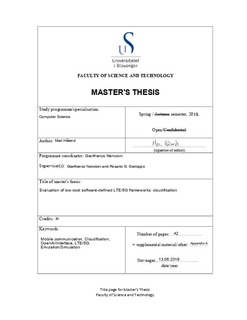Evaluation of low-cost software-defined LTE/5G frameworks: cloudification
Master thesis
Permanent lenke
http://hdl.handle.net/11250/2620500Utgivelsesdato
2019-06Metadata
Vis full innførselSamlinger
- Studentoppgaver (TN-IDE) [877]
Sammendrag
There has been a tremendous rise in mobile communication units over the past decade. Where cellphones once dominated the user market for fast wireless communication solutions, we now see an abundance of devices and appliances being enabled with cellular communication technology to enable high-speed connectivity.
Machine to Machine (M2M) communication services entered the market during the late 2000s with the rise of 3G mobile communication, paving the way for a more generalized approach to mobile communication services that was targeted at industrial instrumentation and automation, without the need for proprietary intermediate interfaces and hub-and-spoke architecture.
Internet of Things (IoT) describes the most recent trend in mobile connectivity, where anything from household appliances to micro-controllers for street lights are enabled with cellular communication technology to enable management, reporting, remote controllability, surveillance and other features. The recent mobile technologies like 4G/LTE enables high-speed, low-latency wireless communication over vast distances, in harsh RF environments, and eliminates the need for cabling and wires between endpoints.
The next evolution in mobile networks comes with 5G, where the key successes from 4G/LTE is evolved to further improve and strengthen the mobility services for both consumer, business and industry segments. ‘More speed’, ‘higher availability’ and ‘enhanced subscriber management’ are terms we know from the vendor sales pitch. The technical side is far more complex, and reveals a subset of technologies that goes deeper into the IoT and M2M branches of mobile communication. This thesis will focus on specific aspects of both 4G/LTE and 5G technologies, looking into how the base stations and radio core elements interact, and respond to changes in the network. With server virtualization and software enablement of the mobile core, components that were previously hosted in-house can now be moved into the cloud. How does this affect performance? What are the consequences of these changes from a Quality of Experience (QoE) perspective? These are questions I will look into in further detail in this thesis.
Beskrivelse
Master's thesis in computer science
